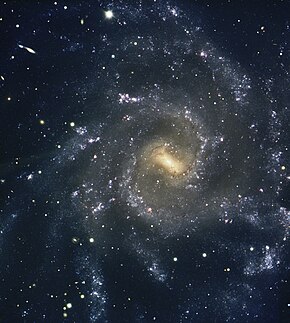
Summary
NGC 7424 is a barred spiral galaxy located 37.5 million light-years away in the southern constellation Grus (the Crane). Its size (about 100,000 light-years) makes it similar to our own galaxy, the Milky Way.[3] It is called a "grand design" galaxy because of its well defined spiral arms. Two supernovae and two ultraluminous X-ray sources have been discovered in NGC 7424.
| NGC 7424 | |
|---|---|
 | |
| Observation data (J2000 epoch) | |
| Constellation | Grus |
| Right ascension | 22h 57m 18s[1] |
| Declination | −41° 04′ 14″ [1] |
| Redshift | 0.003132 (939 ± 2 km/s) [1] |
| Distance | 37.5 Mly (11.5 Mpc)[2] |
| Apparent magnitude (V) | 11.0 [1] |
| Characteristics | |
| Type | SAB(rs)cd [1] |
| Apparent size (V) | 9.5 x 8.1 arcmin [1] |
| Notable features | similar to the Milky Way |
| Other designations | |
| PGC 070096 | |
Characteristics edit
NGC 7424 is intermediate between normal spirals (SA) and strongly barred galaxies (SB). Other features include the presence of a central ring-like structure and a relatively low core brightness relative to the arms. The redder color of the prominent bar indicates an older population of stars while the bright blue color of the loose arms indicates the presence of ionised hydrogen and clusters of massive young stars. NGC 7424 is listed as a member of the IC 1459 Grus Group of galaxies, but is suspected of being a "field galaxy"; that is, not gravitationally bound to any group.[4]
Supernova 2001ig edit
SN 2001ig[5] was a rare Type IIb supernova discovered by Australian amateur Robert Evans on the outer edge of NGC 7424 on 10 December 2001.[6] Type IIb supernovae (SNe) initially exhibit spectral lines of hydrogen (like typical Type II's), but these disappear after a short time to be replaced by lines of oxygen, calcium and magnesium (like typical Type Ib's and Ic's).
In 2006, Anglo-Australian Observatory astronomer Stuart Ryder et al. found what they argued could be the binary companion to SN 2001ig using the Gemini Observatory. It is a massive A or F class star that had an eccentric orbit around the progenitor, a Wolf-Rayet star. They believe that the companion periodically stripped the outer hydrogen-rich envelope of the progenitor, accounting for the observed spectral changes.[7][8] Princeton University fellow Alicia Soderberg et al. also believe that the progenitor was a Wolf-Rayet star, but suggest that the periodic mass loss was a result of the intense stellar wind these stars produce.[9]
In a paper published in March 2018, Ryder et al. announced that the surviving companion had been observed with the Hubble Space Telescope in the ultraviolet.[10] This is the first time a companion to a Type IIb supernova has been imaged.[11]
On 7 March, 2017, Stuart Parker of New Zealand, discovered a supernova: SN 2017bzb (Type II, mag. 13).[12]
Ultraluminous X-ray sources edit
In May and June 2002, Roberto Soria and his colleagues at the Harvard-Smithsonian Center for Astrophysics discovered two Ultraluminous X-ray sources (ULXs) with the Chandra X-ray Observatory. ULXs are objects that emit tremendous amounts of X-rays (> 1032 watts or 1039 erg/s), assuming they radiate isotropically (the same in all directions). This amount is larger than currently understood stellar processes (including supernovae) but smaller than the amount of X-rays emitted by active galactic nuclei, which accounts for their alternate name, Intermediate-luminosity X-ray Objects (IXOs). The source designated ULX1 was found in a relatively empty interarm region, far from any bright clusters or star-forming complexes, and showed a 75% increase in X-ray luminosity over the course of 20 days. ULX2 was found in an exceptionally bright young stellar complex, and showed an order of magnitude increase over the same time period.[2]
References edit
- ^ a b c d e f "NASA/IPAC Extragalactic Database". Results for NGC 7424. Retrieved 26 November 2008.
- ^ a b Soria, R.; et al. (August 2006), "Multiband Study of NGC 7424 and its Two Newly-discovered ULXs", Monthly Notices of the Royal Astronomical Society, 370 (4): 1666–1676, arXiv:astro-ph/0606080, Bibcode:2006MNRAS.370.1666S, doi:10.1111/j.1365-2966.2006.10629.x, S2CID 17098189
- ^ "Explosions in majestic spiral galaxy beauties". Spaceflight Now. 5 December 2004. Retrieved 27 November 2008.
- ^ Yahil, A.; Vidal, N. V. (June 1977), "The Velocity Distribution of Galaxies in Clusters", Astrophysical Journal, 214: 347, Bibcode:1977ApJ...214..347Y, doi:10.1086/155257
- ^ "Light curves and spectra at the Open Supernova Catalog". Archived from the original on 2019-08-23. Retrieved 2017-12-02.
- ^ Green, Daniel W. E. (13 December 2001). "IAU Circular 7772". Retrieved 21 February 2014.
- ^ Ryder, S.; et al. (April 2004), "Modulations in the radio light curve of the Type IIb supernova 2001ig: evidence for a Wolf-Rayet binary progenitor?", Monthly Notices of the Royal Astronomical Society, 349 (3): 1093–1100, arXiv:astro-ph/0401135, Bibcode:2004MNRAS.349.1093R, doi:10.1111/j.1365-2966.2004.07589.x, S2CID 18132819
- ^ Ryder, S.; et al. (June 2006), "A post-mortem investigation of the Type IIb supernova 2001ig", Monthly Notices of the Royal Astronomical Society, 369 (1): L32–L36, arXiv:astro-ph/0603336, Bibcode:2006MNRAS.369L..32R, doi:10.1111/j.1745-3933.2006.00168.x, S2CID 15543433
- ^ Soderberg, A.; et al. (October 2006), "The Radio and X-Ray Luminous SN 2003bg and the Circumstellar Density Variations around Radio Supernovae", Astrophysical Journal, 651 (2): 1005–1018, arXiv:astro-ph/0512413, Bibcode:2006ApJ...651.1005S, doi:10.1086/507571, S2CID 954954
- ^ Ryder, S.; et al. (March 2018), "Ultraviolet Detection of the Binary Companion to the Type IIb SN 2001ig", The Astrophysical Journal, 856 (1): 83, arXiv:1801.05125, Bibcode:2018ApJ...856...83R, doi:10.3847/1538-4357/aaaf1e, S2CID 119383171
- ^ Hille, Karl (2018-04-26). "Stellar Thief Is the Surviving Companion to a Supernova". NASA. Retrieved 27 April 2018.
- ^ Transient Name Server entry for SN 2017bzb. Retrieved 22 March 2023.
External links edit
- Media related to NGC 7424 at Wikimedia Commons


